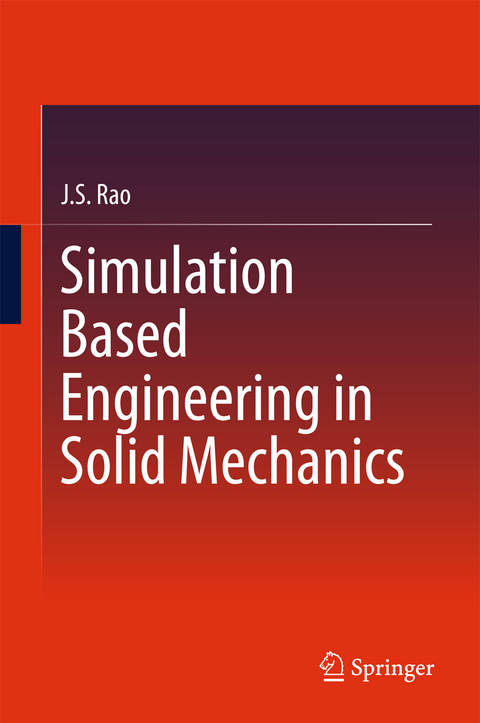
Simulation Based Engineering in Solid Mechanics
Springer International Publishing (Verlag)
978-3-319-47613-1 (ISBN)
This book begins with a brief historical perspective of the advent of rotating machinery in 20th century Solid Mechanics and the development of the discipline of the Strength of Materials. High Performance Computing (HPC) and Simulation Based Engineering Science (SBES) have gradually replaced the conventional approach in Design bringing science directly into engineering without approximations. A recap of the required mathematical principles is given. The science of deformation, strain and stress at a point under the application of external traction loads is next presented. Only one-dimensional structures classified as Bars (axial loads), Rods (twisting loads) and Beams (bending loads) are considered in this book. The principal stresses and strains and von Mises stress and strain that used in design of structures are next presented. Lagrangian solution was used to derive the governing differentialequations consistent with assumed deformation field and solution for deformations, strains and stresses were obtained.
The finite element method most suitable for HPC is derived and the corresponding stiffness matrix for the element is derived. Assembling procedure of these matrices is then described to obtain the system matrices.
Worked examples and exercises are given in each chapter. This book brings SBES at entry level allowing young students to quickly adapt to modern design practices.
J.S. Rao is Chief Science officer at Altair Engineering India Ltd, President of the Vibration Institute of India and Editor in Chief of the Journal of Vibration Engineering and Technologies.
Preface.- Introduction.- 1.1 Matrices.- 1.2 Vectors and Tensors.- 1.3 Energy Principle.- 2 Continuous Solid.- 2.1 External and Internal Tractions.- 2.2. Stress Definition.- 2.3. Equilibrium Relations.- 2.4. Strain.- 2.5. Stress -- Strain Relations.- 2.6 Strain Energy and Work.- 2.7 Von Mises Stress.- 3 Euler-Lagrange Equations.- 3.1 General Approach for solving Structural Problems.- 3.2 Other Applications of Euler-Lagrange Equation leading to Optimization.- 3.3 Derivation of Euler-Lagrange Equation through Delta Operator.- 4 Axially Loaded 1-D Structures.- 4.1 Simply Supported Bar.- 4.2 Simply Supported - Free Bar.- 4.3 Finite Element Method.- 4.4 Thermal Stresses.- 4.5 Principle of Virtual Work4.6 Minimization of Total Potential Energy.- 5 Twisting of a Rod.- 5.1 Finite Element Method for Torsion.- 5.2 Two Elements and Stiffness Matrix Assembly.- 5.3 Ritz Method for Torsion.- 6 Bending of a Beam.- 6.1 Bending by Energy Method.- 6.2 Beam with Axial Load (Beam-Column).- 6.3 Strength ofMaterials Approach.- 6.4 Beam Solution by Energy Method.- 6.5 Beam Finite Element.- 6.6 Buckling revisited.- 6.7 Galerkin Method for Tapered Beams.- 6.8 General Structures by Commercial Solvers.- 7. Epilogue.- Acknowledgements.- Index.
| Erscheinungsdatum | 26.11.2016 |
|---|---|
| Reihe/Serie | SpringerBriefs in Applied Sciences and Technology |
| Zusatzinfo | XIV, 200 p. 100 illus., 56 illus. in color. |
| Verlagsort | Cham |
| Sprache | englisch |
| Maße | 155 x 235 mm |
| Themenwelt | Mathematik / Informatik ► Mathematik ► Wahrscheinlichkeit / Kombinatorik |
| Naturwissenschaften ► Physik / Astronomie ► Mechanik | |
| Technik ► Maschinenbau | |
| Schlagworte | Bars in axial load • Beam Finite Element • classical mechanics • Continuum Mechanics and Mechanics of Materials • Engineering • Engineering design • Engineering: general • FEM • Governing equations for stress • Lateral bending of beams • Mechanical engineering and materials • One definite element method • Rods in twist • SBES • technical design • Thermal stresses • Vectors and Tensors |
| ISBN-10 | 3-319-47613-0 / 3319476130 |
| ISBN-13 | 978-3-319-47613-1 / 9783319476131 |
| Zustand | Neuware |
| Haben Sie eine Frage zum Produkt? |
aus dem Bereich


